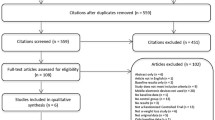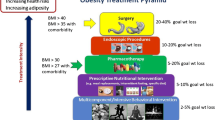ABSTRACT
BACKGROUND
The US Preventive Services Task Force recommends screening for and treating obesity. However, there are many barriers to successfully treating obesity in primary care (PC). Technology-assisted weight loss interventions offer novel ways of improving treatment, but trials are overwhelmingly conducted outside of PC and may not translate well into this setting. We conducted a systematic review of technology-assisted weight loss interventions specifically tested in PC settings.
METHODS
We searched the literature from January 2000 to March 2014. Inclusion criteria: (1) Randomized controlled trial; (2) trials that utilized the Internet, personal computer, and/or mobile device; and (3) occurred in an ambulatory PC setting. We applied the Cochrane Effective Practice and Organization of Care (EPOC) and Delphi criteria to assess bias and the Pragmatic-Explanatory Continuum Indicator Summary (PRECIS) criteria to assess pragmatism (whether trials occurred in the real world versus under ideal circumstances). Given heterogeneity, results were not pooled quantitatively.
RESULTS
Sixteen trials met inclusion criteria. Twelve (75 %) interventions achieved weight loss (range: 0.08 kg – 5.4 kg) compared to controls, while 5–45 % of patients lost at least 5 % of baseline weight. Trial duration and attrition ranged from 3–36 months and 6–80 %, respectively. Ten (63 %) studies reported results after at least 1 year of follow-up. Interventions used various forms of personnel, technology modalities, and behavior change elements; trials most frequently utilized medical doctors (MDs) (44 %), web-based applications (63 %), and self-monitoring (81 %), respectively. Interventions that included clinician-guiding software or feedback from personnel appeared to promote more weight loss than fully automated interventions. Only two (13 %) studies used publically available technologies. Many studies had fair pragmatism scores (mean: 2.8/4), despite occurring in primary care.
DISCUSSION
Compared to usual care, technology-assisted interventions in the PC setting help patients achieve weight loss, offering evidence-based options to PC providers. However, best practices remain undetermined. Despite occurring in PC, studies often fall short in utilizing pragmatic methodology and rarely provide publically available technology. Longitudinal, pragmatic, interdisciplinary, and open-source interventions are needed.




Similar content being viewed by others
REFERENCES
Must A, Spadano J, Coakley EH, Field AE, Colditz G, Dietz WH. The disease burden associated with overweight and obesity. JAMA. 1999;282(16):1523–1529.
Oster G, Edelsberg J, O’Sullivan AK, Thompson D. The clinical and economic burden of obesity in a managed care setting. Am J Manage Care. 2000;6(6):681–689.
Wang YC, McPherson K, Marsh T, Gortmaker SL, Brown M. Health and economic burden of the projected obesity trends in the USA and the UK. Lancet. 2011;378(9793):815–25.
Williams BC, Philbrick JT, Becker DM, McDermott A, Davis RC, Buncher PC. A patient-based system for describing ambulatory medicine practices using diagnosis clusters. J Gen Intern Med. 1991;6(1):57–63.
Ogden CL, Carroll MD, Kit BK, Flegal KM. Prevalence of childhood and adult obesity in the United States, 2011–2012. JAMA. 2014;311(8):806–14.
Berghöfer A, Pischon T, Reinhold T, Apovian CM, Sharma AM, Willich SN. Obesity prevalence from a European perspective: a systematic review. BMC Public Health. 2008;8:200.
Kushner RF. Roadmaps for clinical practice: case studies in disease prevention and health promotion—assessment and management of adult obesity: a primer for physicians. Chicago: American Medical Association; 2003.
Bray GA, Wilson JF. In the clinic. Obesity. Ann Intern Med. 2008;149(7):ITC4–1–15.
National Institute for Health and Clinical Excellence. Obesity: guidance on the prevention, identification, assessment and management of overweight and obesity in adults and childen. NICE clinical guideline no. 43. 2006. Available at http://www.nice.org.uk/CG43. Accessed 7/17/14.
McTigue KM, Harris R, Hemphill B, et al. Screening and interventions for obesity in adults: summary of the evidence for the U.S. Preventive Services Task Force. Ann Intern Med. 2003;139(11):933–49.
Levy RL, Finch EA, Crowell MD, Talley NJ, Jeffery RW. Behavioral intervention for the treatment of obesity: strategies and effectiveness data. Am J Gastroenterol. 2007;102(10):2314–21.
Schappert SM, Rechtsteiner EA. Ambulatory medical care utilization estimates for 2007. Vital Health Stat. 2011;13(169):1–38.
Wing RR, Lang W, Wadden TA, et al. Benefits of modest weight loss in improving cardiovascular risk factors in overweight and obese individuals with type 2 diabetes. Diabetes Care. 2011;34(7):1481–6.
Pi-Sunyer FX. Short-term medical benefits and adverse effects of weight loss. Ann Intern Med. 1993;119:722–6.
Williamson DF, Thompson TJ, Thun M, Flanders D, Pamuk E, Byers T. Intentional weight loss and mortality among overweight individuals with diabetes. Diabetes Care. 2000;23(10):1499–504.
Harrington M, Gibson S, Cottrell RC. A review and meta-analysis of the effect of weight loss on all-cause mortality risk. Nutr Res Rev. 2009;22(1):93–108.
Knowler WC, Barrett-Connor E, Fowler SE, et al. Reduction in the incidence of type 2 diabetes with lifestyle intervention or metformin. N Engl J Med. 2002;346(6):393–403.
Goldstein DJ. Beneficial health effects of modest weight loss. Int J Obes Relat Metab Disord. 1992;16(6):397–415.
Appel LJ, Champagne CM, Harsha DW, et al. Effects of comprehensive lifestyle modification on blood pressure control: main results of the PREMIER clinical trial. JAMA. 2003;289(16):2083–93.
Wadden TA, West DS, Neiberg RH, et al. One-year weight losses in the Look AHEAD study: factors associated with success. Obesity (Silver Spring). 2009;17(4):713–22.
Sacks FM, Bray GA, Carey VJ, et al. Comparison of weight-loss diets with different compositions of fat, protein, and carbohydrates. N Engl J Med. 2009;360(9):859–73.
Cecchini M, Sassi F, Lauer JA, YY L, Guajardo-Barron V, Chisholm D. Tackling of unhealthy diets, physical inactivity, and obesity: health effects and cost-effectiveness. Lancet. 2010;376(9754):1775–84.
Sciamanna CN, Tate DF, Lang W, Wing RR. Who reports receiving advice to lose weight? Results from a multistate survey. Arch Intern Med. 2010;160(15):2334–9.
McTigue KM, Conroy MB. Use of the internet in the treatment of obesity and prevention of type 2 diabetes in primary care. Proc Nutr Soc. 2013;72(1):98–108.
Kushner RF. Barriers to providing nutrition counseling by physicians: a survey of primary care practitioners. Prev Med (Baltimore). 1995;24(6):546–52.
Forman-Hoffman V, Little A, Wahls T. Barriers to obesity management: a pilot study of primary care clinicians. BMC Fam Pract. 2006;7:35.
Foster GD, Wadden TA, Makris AP, et al. Primary care physicians’ attitudes about obesity and its treatment. Obes Res. 2003;11(10):1168–77.
Yarnall KSH, Pollak KI, Østbye T, Krause KM, Michener JL. Primary care: is there enough time for prevention? Am J Public Health. 2003;93(4):635–41.
Iacobucci G. Pay GPs to tackle obesity, doctors urge UK government. BMJ. 2014;348:g232.
Block JP, DeSalvo KB, Fisher WP. Are physicians equipped to address the obesity epidemic? Knowledge and attitudes of internal medicine residents. Prev Med. 2003;36(6):669–75.
Jay M, Gillespie C, Ark T, et al. Do internists, pediatricians, and psychiatrists feel competent in obesity care?: using a needs assessment to drive curriculum design. J Gen Intern Med. 2008;23(7):1066–70.
Stafford RS, Farhat JH, Misra B, Schoenfeld DA. National patterns of physician activities related to obesity management. Arch Fam Med. 2000;9(7):631–8.
Schauffler HH, Rodriguez T, Milstein A. Health education and patient satisfaction. J Fam Pract. 1996;42(1):62–8.
Bleich SN, Pickett-Blakely O, Cooper LA. Physician practice patterns of obesity diagnosis and weight-related counseling. Patient Educ Couns. 2011;82(1):123–9.
Levy BT, Williamson PS. Patient perceptions and weight loss of obese adults. J Fam Pract. 1988;27(3):285–90.
Potter MB, Vu JD, Croughan-Minihane M. Weight management: what patients want from their primary care physicians. J Fam Pract. 2001;50(6):513–8.
Budman SH, Portnoy D, Villapiano AJ. How to get technological innovation used in behavioral health care: Build it and they still might not come. Psychother Theory Res Prac Train. 2013;40:45–54.
Tate DF, Wing RR, Winett RA. Using Internet technology to deliver a behavioral weight loss program. JAMA. 2001;285(9):1172–7.
Harvey-Berino J, West D, Krukowski R, et al. Internet delivered behavioral obesity treatment. Prev Med. 2010;51(2):123–8.
Wieland LS, Falzon L, Sciamanna CN, et al. Interactive computer-based interventions for weight loss or weight maintenance in overweight or obese people. Cochrane Database Syst Rev. 2012;8:CD007675.
Neve M, Morgan PJ, Jones PR, Collins CE. Effectiveness of web-based interventions in achieving weight loss and weight loss maintenance in overweight and obese adults: a systematic review with meta-analysis. Obes Rev. 2010;11(4):306–21.
Arem H, Irwin M. A review of web-based weight loss interventions in adults. Obes Rev. 2011;12(5):e236–43.
Tsai AG, Wadden TA. Systematic review: an evaluation of major commercial weight loss programs in the United States. Ann Intern Med. 2005;142(1):56–66.
Glasgow RE, Gaglio B, Bennett G, et al. Applying the PRECIS criteria to describe three effectiveness trials of weight loss in obese patients with comorbid conditions. Health Serv Res. 2012;47:1051–67.
Thorpe KE, Zwarenstein M, Oxman AD, et al. A pragmatic-explanatory continuum indicator summary (PRECIS): a tool to help trial designers. J Clin Epidemiol. 2009;62(5):464–75.
Moher D, Liberati A, Tetzlaff J, Altman DG. Preferred reporting items for systematic reviews and meta-analyses: the PRISMA statement. PLoS Med. 2009;6(7):e1000097.
http://www.crd.york.ac.uk/PROSPERO/display_record.asp?ID=CRD42013003998. Accessed 7/17/14.
Bravata D, Smith-Spangler C, Sundaram V, et al. Using pedometers to increase physical activity and improve health: a systematic review. JAMA. 2007;298(19):2296–2304.
Richardson CR, Newton TL, Abraham JJ, Sen A, Jimbo M, Swartz AM. A Meta-Analysis of Pedometer-Based Walking Interventions and Weight Loss. Ann Fam Med. 2008;6(1):69–77.
Tsai AG, Wadden TA. Treatment of obesity in primary care practice in the United States: a systematic review. J Gen Intern Med. 2009;24(9):1073–9.
Lefebvre C, Manheimer E, Glanville J. Chapter 6: searching for studies. In: Higgins JPT, Green S, editors. Cochrane handbook for systematic reviews of interventions. Version 5.0.2 [updated September 2009]. The Cochrane Collaboration, 2009.
US Preventive Services Task Force. Screening for obesity in adults: recommendations and rationale. Ann Intern Med. 2003;139(11):930–2.
Bensley RJ, Brusk JJ, Rivas J. Key principles in internet-based weight management systems. Am J Health Behav. 2010;34(2):206–13.
Verhagen AP, de Vet HC, de Bie RA, et al. The Delphi list: a criteria list for quality assessment of randomized clinical trials for conducting systematic reviews developed by Delphi consensus. J Clin Epidemiol. 1998;51(12):1235–41.
Cochrane Effective Practice and Organisation of Care Review Group. Risk of bias. 2009. Available at: http://epoc.cochrane.org/sites/epoc.cochrane.org/files/uploads/Suggested%20risk%20of%20bias%20criteria%20for%20EPOC%20reviews.pdf. Accessed 7/17/14.
Verhagen AP, de Vet HC, de Bie RA, Boers M, van den Brandt PA. The art of quality assessment of RCTs included in systematic reviews. J Clin Epidemiol. 2001;54(7):651–4.
Koppenaal T, Linmans J, Knottnerus JA, Spigt M. Pragmatic vs explanatory: an adaptation of the PRECIS tool helps to judge the applicability of systematic reviews for daily practice. J Clin Epidemiol. 2011;64(10):1095–101.
Appel LJ, Clark MJ, Yeh HC, et al. Comparative effectiveness of weight-loss interventions in clinical practice. N Engl J Med. 2011;365:1959–68.
Bennett GG, Herring SJ, Puleo E, Stein EK, Emmons KM, Gillman MW. Web-based weight loss in primary care: a randomized controlled trial. Obesity (Silver Spring). 2010;18(2):308–13.
Bennett GG, Warner ET, Glasgow RE, et al. Obesity treatment for socioeconomically disadvantaged patients in primary care practice. Arch Intern Med. 2012;172(7):565–74.
Christian JG, Bessesen DH, Byers TE, Christian KK, Goldstein MG, Bock BC. Clinic-based support to help overweight patients with type 2 diabetes increase physical activity and lose weight. Arch Intern Med. 2008;168(2):141–6.
Christian JG, Byers TE, Christian KK, et al. A computer support program that helps clinicians provide patients with metabolic syndrome tailored counseling to promote weight loss. J Am Diet Assoc. 2011;111(1):75–83.
Ma J, Yank V, Xiao L, et al. Translating the Diabetes Prevention Program lifestyle intervention for weight loss into primary care: a randomized trial. JAMA Intern Med. 2013;173(2):113–21.
McConnon A, Kirk SF, Cockroft JE, et al. The Internet for weight control in an obese sample: results of a randomised controlled trial. BMC Health Serv Res. 2007;7:206.
McDoniel SO, Wolskee P, Shen J. Treating obesity with a novel hand-held device, computer software program, and Internet technology in primary care: the SMART motivational trial. Patient Educ Couns. 2010;79(2):185–91.
Mehring M, Haag M, Linde K, et al. Effects of a general practice guided web-based weight reduction program–results of a cluster-randomized controlled trial. BMC Fam Pract. 2013;14(1):76.
Nanchahal K, Townsend J, Letley L, Haslam D, Wellings K, Haines A. Weight-management interventions in primary care: a pilot randomised controlled trial. Br J Gen Pract. 2009;59(562):e157–66.
Nanchahal K, Power T, Holdsworth E, et al. A pragmatic randomised controlled trial in primary care of the Camden Weight Loss (CAMWEL) programme. BMJ Open. 2012;2(3).
Rothert K, Strecher V, Doyle L. Web based Weight Management Programs in an Integrated Health Care Setting: A Randomized. Controlled Trial. Obesity. 2006;14(2):266–272.
Spring B, Duncan JM, Janke EA, et al. Integrating technology into standard weight loss treatment: a randomized controlled trial. JAMA Intern Med. 2013;173(2):105–11.
ter Bogt NCW, Bemelmans WJE, Beltman FW, Broer J, Smit AJ, van der Meer K. Preventing Weight Gain by Lifestyle Intervention in a General Practice Setting. Arch Intern Med. 2011;171(4):306–313.
Verheijden M, Bakx JC, Akkermans R, et al. Web-based targeted nutrition counselling and social support for patients at increased cardiovascular risk in general practice: randomized controlled trial. J Med Internet Res. 2004;6(4):e44.
Wylie-Rosett J, Swencionis C, Ginsberg M, et al. Computerized Weight Loss Intervention Optimizes Staff Time. J Am Diet Assoc. 2001;101(10):1155–1162.
ter Bogt NCW, Bemelmans WJE, Beltman FW, Broer J, Smit AJ, van der Meer K. Preventing weight gain: one-year results of a randomized lifestyle intervention. Am J Prev Med. 2009;37(4):270–7.
Khaylis A, Yiaslas T, Bergstrom J, Gore-Felton C. A review of efficacious technology-based weight-loss interventions: five key components. Telemed J E Health. 2010;16(9):931–8.
McCombie L, Lean MEJ, Haslam D. Effective UK weight management services for adults. Clin Obes. 2012;2(3–4):96–102.
Bennett GG, Glasgow RE. The delivery of public health interventions via the Internet: actualizing their potential. Annu Rev Public Health. 2009;30:273–92.
Krukowski RA, Harvey-Berino J, Ashikaga T, Thomas CS, Micco N. Internet-based weight control: the relationship between web features and weight loss. Telemed J E Health. 2008;14(8):775–82.
Xiao L, Yank V, Wilson SR, Lavori PW, Ma J. Two-year weight-loss maintenance in primary care-based Diabetes Prevention Program lifestyle interventions. Nutr Diabetes. 2013;3:e76.
Yoong SL, Carey M, Sanson-Fisher R, Grady A. A systematic review of behavioural weight-loss interventions involving primary-care physicians in overweight and obese primary-care patients (1999–2011). Public Health Nutr. 2013;16(11):2083–99.
Kodama S, Saito K, Tanaka S, et al. Effect of Web-based lifestyle modification on weight control: a meta-analysis. Int J Obes. 2012;36(5):675–85.
Reed VA, Schifferdecker KE, Rezaee ME, O’Connor S, Larson RJ. The effect of computers for weight loss: a systematic review and meta-analysis of randomized trials. J Gen Intern Med. 2012;27(1):99–108.
Morgan PJ, Lubans DR, Collins CE, Warren JM, Callister R. 12-month outcomes and process evaluation of the SHED-IT RCT: an internet-based weight loss program targeting men. Obesity (Silver Spring). 2011;19(1):142–51.
Morgan PJ, Callister R, Collins CE, et al. The SHED-IT community trial: a randomized controlled trial of internet- and paper-based weight loss programs tailored for overweight and obese men. Ann Behav Med. 2013;45(2):139–52.
Whittaker R, McRobbie H, Bullen C, Borland R, Rodgers A, Gu Y. Mobile phone-based interventions for smoking cessation. Cochrane Database Syst Rev. 2012;11:CD006611.
Shahab L, McEwen A. Online support for smoking cessation: a systematic review of the literature. Addiction. 2009;104(11):1792–804.
Vervloet M, van Dijk L, Santen-Reestman J, et al. SMS reminders improve adherence to oral medication in type 2 diabetes patients who are real time electronically monitored. Int J Med Inform. 2012;81(9):594–604.
Lester RT, Ritvo P, Mills EJ, et al. Effects of a mobile phone short message service on antiretroviral treatment adherence in Kenya (WelTel Kenya1): a randomised trial. Lancet. 2010;376(9755):1838–45.
Bacigalupo R, Cudd P, Littlewood C, Bissell P, Hawley MS, Buckley WH. Interventions employing mobile technology for overweight and obesity: an early systematic review of randomized controlled trials. Obes Rev. 2013;14(4):279–91.
Chang T, Chopra V, Zhang C, Woolford SJ. The role of social media in online weight management: systematic review. J Med Internet Res. 2013;15(11):e262.
Ritzwoller DP, Glasgow RE, Sukhanova AY, et al. Economic analyses of the Be Fit Be Well program: a weight loss program for community health centers. J Gen Intern Med. 2013;28(12):1581–8.
Tsai AG, Wadden TA, Volger S, et al. Cost-effectiveness of a primary care intervention to treat obesity. Int J Obes. 2013;37(S1):S31–7.
Loges WE, Jung J-Y. Exploring the Digital Divide: Internet Connectedness and Age. Commun Res. 2001;28(4):536–562.
Acknowledgements
Contributors
We would like to thank Adina Kalet, MD, MPH for her feedback and editing of the manuscript.
Funders
Veteran Affairs Career Development Award
Prior presentations
Levine D, Savarimuthu S, Nicholson J, Jay M. Technology-assisted weight loss interventions in primary care: A systematic review. Poster Presentation, Society of General Internal Medicine; Denver, CO 2013.
Conflict of Interest
The authors declare that they do not have any conflicts of interest.
Author information
Authors and Affiliations
Corresponding author
Additional information
Registration
PROPSERO CRD42013003998
Electronic supplementary material
Below is the link to the electronic supplementary material.
ESM 1
(DOCX 66 kb)
Rights and permissions
About this article
Cite this article
Levine, D.M., Savarimuthu, S., Squires, A. et al. Technology-Assisted Weight Loss Interventions in Primary Care: A Systematic Review. J GEN INTERN MED 30, 107–117 (2015). https://doi.org/10.1007/s11606-014-2987-6
Received:
Revised:
Accepted:
Published:
Issue Date:
DOI: https://doi.org/10.1007/s11606-014-2987-6




